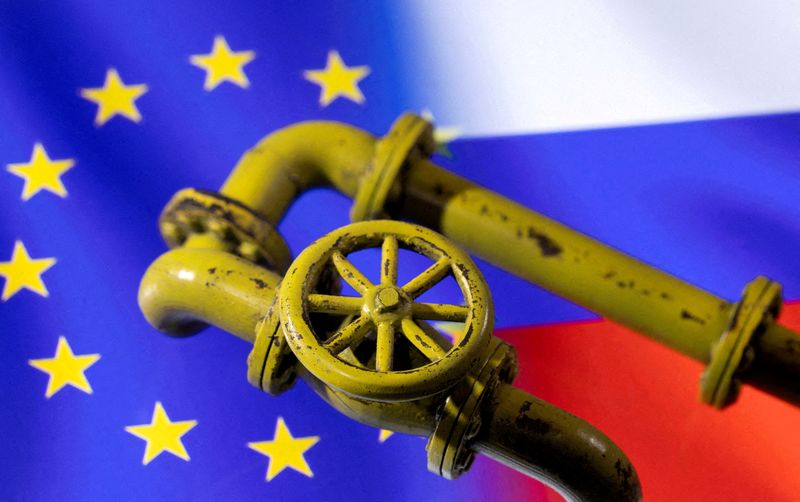By Nina Chestney
LONDON (Reuters) -Russian gas flows to Europe via Ukraine fell by a quarter on Wednesday after Kyiv halted use of a major transit route blaming interference by occupying Russian forces, the first time exports via Ukraine have been disrupted since the invasion.
Ukraine has remained a major transit route for Russian gas to Europe even after Moscow launched what it calls a "special military operation" in the country on Feb. 24.
The transit point Ukraine shut usually handles about 8% of Russian gas flows to Europe, although European states said they were still receiving supplies. The Ukraine corridor mostly sends gas to Austria, Italy, Slovakia and other east European states.
Kremlin-controlled Gazprom (MCX:GAZP), which has a monopoly on Russian gas exports by pipeline, said it was still shipping gas to Europe via Ukraine, but volumes were seen at 72 million cubic metres (mcm) on Wednesday, down from 95.8 mcm on Tuesday.
GTSOU, which operates Ukraine's gas system, said on Tuesday it would suspend flows through the Sokhranovka transit point, which it said delivered almost a third of fuel piped from Russia to Europe via Ukraine.
GTSOU said it was declaring "force majeure", invoked when a business is hit by something beyond its control, and proposed diverting deliveries for Europe to the Sudzha entry point, the biggest of Ukraine's two crossing points.
The head of Ukraine's gas transit system said Russia closed two valves in the gas network on occupied Ukrainian territory and the value of the gas lost could add up to around $1 billion a month.
The gas pipeline via the Sokhranovka point runs through Ukraine's Luhansk region, part of which has been under control of pro-Russian separatists. Sudzha lies further north-west.
Kremlin spokesman Dmitry Peskov said Russia remained committed to deals to supply gas, when asked to comment on the row with Ukraine over the transit route.
Russia's Gazprom said the security of gas supplies has been undermined by Ukraine shutting one entry point for Russian gas transit to Europe.
Last month, Bulgaria and Poland refused to pay for Russian gas via a new payment mechanism and had their supplies stopped. With the Sokhranovka point now closed, up to a third of Europe's gas supplies could be disrupted, analysts said.
REPLACING RUSSIAN FLOWS
Wednesday's disruption drove Europe's benchmark gas price for the third quarter up to 100 euros per megawatt hour at the market open before slipping back. The price is more than 250% above its level a year ago. [NG/EU]
Ukraine's gas transit operator said it has proposed to Gazprom it could move transit volumes to Sudzha at no extra cost but Gazprom says it is not technically possible to shift all volumes to the route.
Daily gas flows via Sokhranovka have averaged 23 mcm so far this month, 20% lower than the previous month, according to consultancy Rystad Energy. Last year, the EU imported around 155 billion cubic metres (bcm) of gas from Russia overall.
Daily flows via Sudzha have averaged around 70 mcm this month, near its 77 mcm/day capacity. While another 6 mcm/day could potentially be added on top of that, 10 mcm/day of gas flow would need to be re-directed via other routes, where capacity seems to be full, Rystad Energy said.
Ukraine's gas transit operator, however, said Sudzha's daily capacity could reach as much as 244 million cubic metres (mcm).
Most European countries have cut reliance on Russian gas in recent years but it remains the EU's top supplier. Some countries have alternative sources of supply, although replacing all Russian flows presents a challenge given the global gas market was tight even before the Ukraine war.
Slovak Economy Minister Richard Sulik said the flow of gas to Slovakia from Ukraine was stable and there were no signs of a supply problem, while Austrian energy group OMV said its gas deliveries were running according to requests.
Europe also receives Russian gas via Poland through the Yamal-Europe pipeline and via the Nord Stream 1 pipeline under the Baltic Sea to Germany.
German Economy Minister Robert Habeck said gas deliveries to Germany were stable, seeing no reason to move to the next phase of an emergency plan after triggering a first phase in March.
In Italy - which last year consumed 76 billion cubic metres (bcm) of gas about 40% of which was imported from Russia via Ukraine - energy transition minister Roberto Cingolani said moves to find alternative supplies would end the country's reliance on Moscow by the second half of 2024.
But measures needed to be phased in over time and he warned a halt to Russian flows this month would create a serious problem filling storage sites ahead of winter.
Europe is racing to build a buffer of stored gas to help cope with potential supply disruptions and reduce Russia's leverage.
EU gas stocks are about 37% full, according to Gas Infrastructure Europe data, an improvement on a couple of months ago but still below normal for the time of year.

"The knock-on effect of removing a further pipeline from Europe’s gas grid...will make it harder for countries to meet their storage targets and hasten Europe’s plans to move away from imports of Russian gas," said Rystad Energy analyst Zongqiang Luo.
"As the European gas grid is well integrated, no one country is likely to suffer any immediate impact, but this will put further strain on the system and place a floor on downside price movement," he added.
